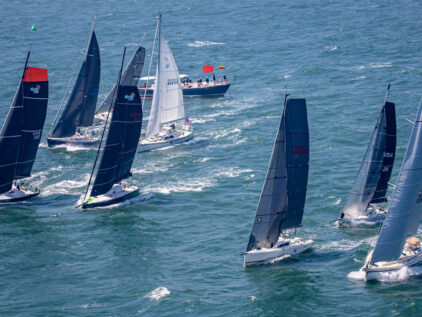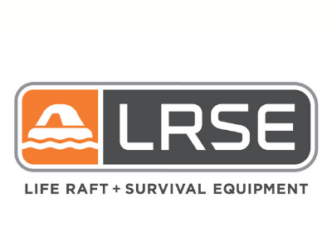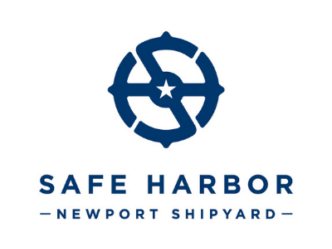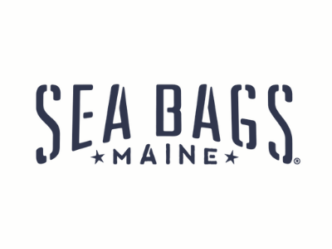Plan Your 2024 Race: From Start to Finish (Webinar Recording & Transcript)
Embark on the Newport Bermuda Race with confidence! On April 24th, 2024 (Wednesday) at 7pm EST we held an exclusive webinar sharing invaluable insights and strategies to craft your game plan for the 636-mile voyage to Bermuda.
Race Chair Andrew Kallfelz, held a Q&A with North Sails expert and Ocean Race Champion, Charlie Enright, dove into essential starting strategies tailored for Narragansett Bay, setting you up for success right from the outset. Additionally, Gulf Stream expert Frank Bohlen shared with the necessary resources and tactics to navigate this challenging leg of the race seamlessly.
Whether you're a seasoned sailor or new to offshore racing, this webinar recording is a gateway to effective race planning. Don't miss this opportunity to prepare for the ultimate sailing adventure. We would like to thank North Sails, our Official Performance Partner, for their support of this webinar and Charlie and Frank for sharing their time with us.
Links to resources mentioned in this webinar:
- Revolution Wind Farm Construction Charts: https://us.orsted.com/renewable-energy-solutions/offshore-wind/mariners#navigational-resources
- Competitor Bulletin #6: https://bermudarace.com/competitor-bulletin-6-important-entry-deadlines-crew-requirements-starting-information-and-wind-farms/
- Gulf Stream Resources: https://bermudarace.com/resources/gulfstream/
About the Speakers
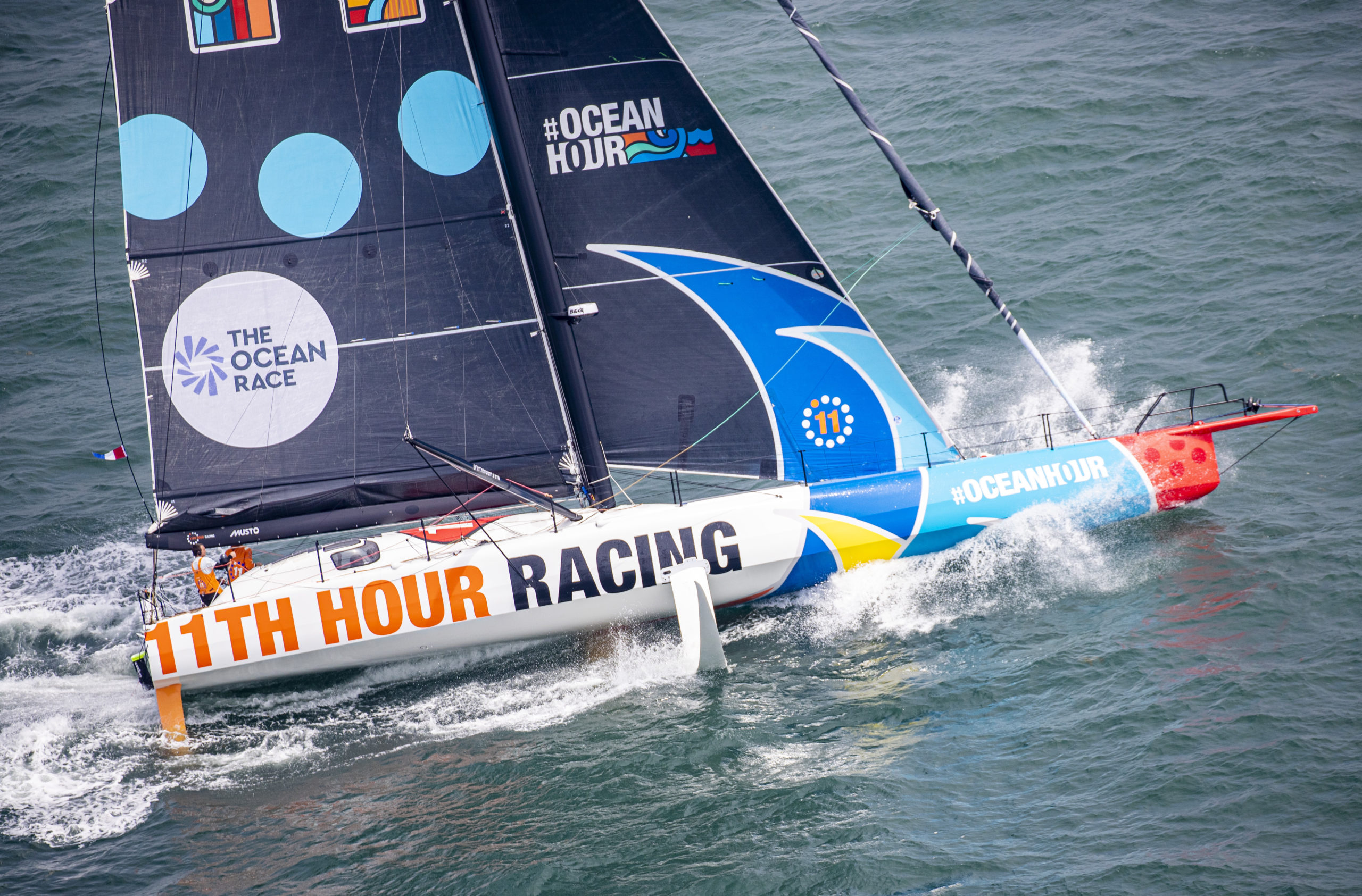
Photo Credit: Daniel Forster
In July of last year, Charlie Enright captained his 11th Hour Racing Team to a historic victory in The Ocean Race, marking the first time an American team claimed the esteemed trophy. As a seasoned sailor hailing from Narragansett Bay, Charlie has extensive experience racing in our newly designated starting area off Fort Adams. Drawing from his wealth of knowledge, he will offer valuable insights and starting strategies tailored to help you navigate out of the Bay and position yourself for success.
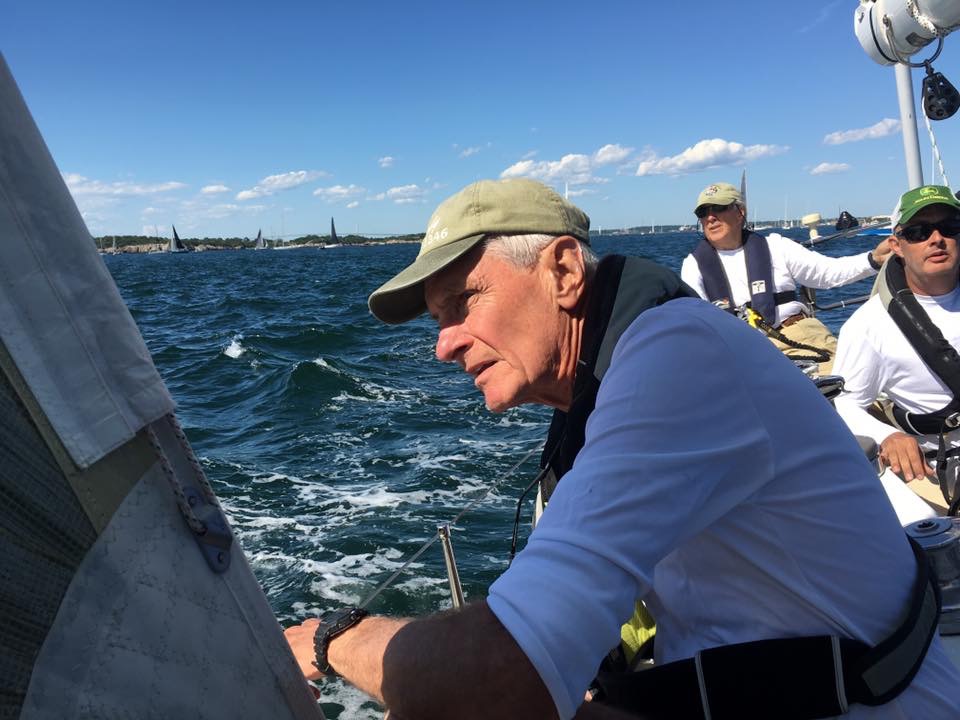
Photo: Chris Museler
For more than 40 years, Frank Bohlen has studied ocean and nearshore currents and transport. Since 2002 he has prepared detailed analyses of the ocean between Newport and Bermuda in the months prior to this race. He has already started to update our Gulf Stream and Weather resource page.
Featured Photo: Daniel Forster
Transcript:
WEBVTT
00:01:36.000 --> 00:01:42.000
Well, Andrew, at 7 o'clock if you wanna go ahead and. Take it away.
00:01:42.000 --> 00:01:45.000
Sounds great. Well, welcome everybody. I think we're supposed to have around 400 and somewhat people joining us tonight.
00:01:45.000 --> 00:01:59.000
So people are jumping in right now so I'll sort of do a slow intro. And by the time we get to the meet of it, hopefully everyone will be online.
00:01:59.000 --> 00:02:14.000
I'd like to welcome Charlie Enright. Tonight who's going to help us understand a little bit about the starting area and hopefully reduce everyone's or anyone's anxieties about, having a start right in front of Ford Adams, which I think will be.
00:02:14.000 --> 00:02:26.000
Very exciting and a nice improvement for the race. And then subsequent to that. There'll be time for some questions and people can use the QA button, I think, and ask some questions.
00:02:26.000 --> 00:02:32.000
Is that right, Kate? And we'll see them and we can answer some of those that aren't answered, as we go along.
00:02:32.000 --> 00:02:46.000
And then we're going to have a quick, I'm gonna do a quick talk about the wind farms and then we're gonna move on and have Frank give us the 1st of a couple I believe a Gulf Stream updates as we approach the 1st of a couple, I believe, a Gulf Stream updates as we approach, race day.
00:02:46.000 --> 00:02:53.000
And with that, I'm gonna, I'm gonna kick it off, with Charlie, and it's gonna be a little question and answer format.
00:02:53.000 --> 00:03:05.000
I'm gonna throw some questions at Charlie that hopefully he can expound on expand on and answer the questions before they're even asked by by most of you who have them.
00:03:05.000 --> 00:03:09.000
So, Kate, could you throw up a little bit of the graphic of the starting area?
00:03:09.000 --> 00:03:20.000
Because I think Charlie is gonna probably want to talk to that a little bit. And once we see that on screen.
00:03:20.000 --> 00:03:24.000
There we go. I was going to just ask Charlie to give us a little overview of the box and I can chime in with some of the detail that he might, not be so familiar with.
00:03:24.000 --> 00:03:52.000
He hasn't studied this for, months and months like I have. But Charlie, if you would just give us an overview of the new starting area, some of the, you know, dimensions at play, if you would, and, general how the starting area sets up as a comparison to not only where we've raced in the past here at the but also some of the other races you've
00:03:52.000 --> 00:04:05.000
done around the world. And by way of introduction, I should also say those of you who are not aware, Charlie's done a little bit of racing and offshore racing and has, had a lot of experience starting in the South Bay here.
00:04:05.000 --> 00:04:13.000
So. Charlie speaks from a position of experience here, not just with Narragansett Bay with, but also with how it starts.
00:04:13.000 --> 00:04:23.000
Play into a rather longer race. So with that, Charlie, why don't you give us an overview at least of how you see this start in the new start area.
00:04:23.000 --> 00:04:34.000
Cool. Well, you know, thanks. Thanks for having me. Definitely done a lot of, offshore sailboat starts, inclusive of the Bermuda Race on the old line.
00:04:34.000 --> 00:04:53.000
Even as recently as as 22 you know but i think the idea behind the new location is to You know, make it a little bit more fan friendly and to, you know, bring the public to the start line, at 4 Adams, which, which, which I think is great.
00:04:53.000 --> 00:05:01.000
You know, but it does make for a slightly more complicated exit. But one I think that we should embrace, certainly.
00:05:01.000 --> 00:05:10.000
You know, if you know the Bermuda Race, you know, the Bermuda Race is, you know, undisputably one of the great 600 mile, you know, races that exist throughout the globe.
00:05:10.000 --> 00:05:16.000
And if you look at a bunch of the other ones, you know, the Sydney Hobart, the Fastenat, the Middle C race, I mean, they all start in, you know, locations that are, that are much more complicated than this.
00:05:16.000 --> 00:05:41.000
So, you know, I think there's a bunch of things to think about, when you leave the doc in the morning, kind of where you want to do your prep and, just looking at it, I think most of that will probably be up in the bay you know i don't think it's a bad idea to make sure you got everything squared away there and maybe kind of tuck
00:05:41.000 --> 00:05:55.000
in behind the Kind of behind clingstone over on the Jamestown shore and kind of wait your turn for your start to come but in theory it should all kind of be the same in terms of the length of the line, the number of boats on the line.
00:05:55.000 --> 00:06:03.000
And when you start, there could be a little bit more maneuvering depending upon the wind direction and what kind of boat you're sailing for sure.
00:06:03.000 --> 00:06:10.000
So I think kind of wrapping your head around that is. Is gonna be a big part of your pre start game plan.
00:06:10.000 --> 00:06:19.000
But, you know, Frank will talk a little bit more about your race game plan later, but I think it's also important to point out that.
00:06:19.000 --> 00:06:27.000
You know, the start is important for sure and, it's good for taking pictures, but it is a very small part of a 600 mile race.
00:06:27.000 --> 00:06:29.000
So I think. You know, being conservative is, is a really good idea and you can't win the race at the start, but you can definitely lose it.
00:06:29.000 --> 00:06:43.000
As the old adage says, you know, you definitely want to be the person that didn't have a good start, but one into Bermuda versus the person that was talking about how good a start they had, but ended up 10th in class or something like that.
00:06:43.000 --> 00:06:59.000
So you got to do the big things right? The start is just part of it. So, you know, it's a good time to be conservative and, As far as approaching the line, I think you guys know this probably better than I because I'm currently not doing the race.
00:06:59.000 --> 00:07:08.000
So I haven't read the documentation as closely as you have, but if you are over, you can't go back and I believe it's a 30 min penalty, which is not insignificant.
00:07:08.000 --> 00:07:09.000
So. Anyway, you know, I think they, change the starting time so that everyone's kind of starting on the same tide.
00:07:09.000 --> 00:07:36.000
You know, the line should be similar in length to what it was before. Potentially not. Totally square to the wind but that presents you know opportunity and i think that it's gonna be a pretty cool thing for everybody on the shore to see and kinda take part of.
00:07:36.000 --> 00:07:42.000
That's great. Couple of questions that I have. And it deals with the tide issue.
00:07:42.000 --> 00:07:50.000
Normally we would start at around one o'clock with actually warning gun at one o'clock and the 1st start at 10 after one in the afternoon.
00:07:50.000 --> 00:07:56.000
Turns out there's a tide shift just at 1 10 actually 1 12. So we've pushed the 1st start back by an hour.
00:07:56.000 --> 00:08:05.000
So everyone's gonna be starting. On an incoming tide. And if tied, were your only consideration, Charlie, where would you be on the starting line?
00:08:05.000 --> 00:08:23.000
On an incoming tide, you know, there's, more water running into the bay in the middle, certainly like an hour after the switch depending upon you know, what's been going on from, media standpoint, the tide could be changed everywhere on the line.
00:08:23.000 --> 00:08:39.000
I think everybody on the call is aware that it changes 1st in shore. So maybe an hour later for some of the 1st starts depending upon what's going on with run off and what's coming out of the river and whatnot, you know, there could actually be a little Outbound push still in the middle of the day.
00:08:39.000 --> 00:08:51.000
So that's something to keep an eye on while you're preparing up in the bay. There'll be plenty of lobster traps and stuff like that to get a good beat on what the currents actually doing, but in theory it should be switched for everybody.
00:08:51.000 --> 00:08:59.000
So a little bit of relief on, on the shore, but, you know, I think you're really trying to use the current to time your.
00:08:59.000 --> 00:09:11.000
Approach to the line and makes you know it's helping you be conservative which which I think is good and yeah but I think it's more about minimizing the maneuvers and getting off clean.
00:09:11.000 --> 00:09:16.000
Then it is really talking about the overall strategy at this stage of the game.
00:09:16.000 --> 00:09:24.000
Right. And I guess the point to highlight there is If we were bully racing, we probably all are just short tacking up the shore.
00:09:24.000 --> 00:09:34.000
But there's not much running room if you start at the PIN and you're heading towards shore and you know in a classic south westerly so And I think your points well taken that.
00:09:34.000 --> 00:09:42.000
Really, it's about minimizing maneuvers, especially because we're set up for some offshore work, not necessarily, but we work in terms of crew and configuration.
00:09:42.000 --> 00:09:51.000
So. Trying to take the best advantage of a little relief at shore might not be the might not be your primary focus is that right
00:09:51.000 --> 00:10:00.000
Yeah, for sure. And I think it, you know. It can get pretty complicated. You know, ensure with the continuing obstruction and, to attack and whatnot.
00:10:00.000 --> 00:10:07.000
So I think you find yourself in those situations, which is probably very likely in a southwesterly, which is not to be a worry, but just to be managed.
00:10:07.000 --> 00:10:15.000
I think a lot of communication early on, boat to boat in these scenarios, really helps.
00:10:15.000 --> 00:10:23.000
I think, you know, calling for room to attack, you know, boats acknowledging that, saying you tack or attacking immediately.
00:10:23.000 --> 00:10:28.000
Those are some of the only words that are actually in the rule book, that you're kind of required to use.
00:10:28.000 --> 00:10:41.000
But I think the big thing is there's a couple of marks in here and you can kind of see the dumpling marks over by James sound and you can see I don't know if you can see it in there but there's cattle bottom just south of, James down there where it jets out.
00:10:41.000 --> 00:10:51.000
You wanna be kind of thinking about these big key points if you're in a South westerly and whether or not you can lay them as to how many maneuvers you're going to end up doing getting out of the bay.
00:10:51.000 --> 00:10:57.000
I think, you know, immediately about the dumpling, I think about kettle bottom, I think about our 6 right off of Castle Hill.
00:10:57.000 --> 00:11:14.000
But you want to be thinking about those when you're kind of planning your exit and trying to minimize the maneuvers as best you can while positioning yourself well relative to the fleet and also kind of taking into consideration the current and, you know, I think the currents obviously a bigger factor if there's less wind.
00:11:14.000 --> 00:11:20.000
And just kind of managing all of those things as you kind of create your pre start game plan.
00:11:20.000 --> 00:11:27.000
And, you can kind of do the armchair quarterback thing and you can look at the tide and look at the weather and decide what you think you're gonna do.
00:11:27.000 --> 00:11:28.000
And then, yeah, well and advanced and then adjust it as you get out there and see the current conditions.
00:11:28.000 --> 00:11:34.000
On the water.
00:11:34.000 --> 00:11:49.000
That's great. You mentioned that We're likely to see similar number of boats on the starting line and I think that by and large that's true, although I do want to learn everybody that the likelihood is it might be a few more boats on the line than you're used to in the past.
00:11:49.000 --> 00:11:57.000
We're likely to be compressing the number of starts down from with 17 starts in the 2022 cycle.
00:11:57.000 --> 00:12:08.000
We did have a hundred 93 boats or something like that starting. So it was, you know, maybe 1520 more boats than we have right now or expect to have.
00:12:08.000 --> 00:12:17.000
We're going to have between 10 and 12 starts probably this this cycle. So we are going to be combining a couple of classes to, you know, compress our starting sequence to under 2 h total, which means you might be seeing more both on the line that you've seen in the past.
00:12:17.000 --> 00:12:31.000
Average, you know, starting line size last year was, starting class size was somewhere around 12.
00:12:31.000 --> 00:12:32.000
I think the largest was wait a couple starts at 15. We might be having starts of 20 to 25.
00:12:32.000 --> 00:12:44.000
But I think most of them will still be in the, you know, under 20 range. So you could see a couple more votes on the line.
00:12:44.000 --> 00:12:48.000
Then you're used to in the past as we, do try to compress things a little bit.
00:12:48.000 --> 00:12:57.000
And I think It might be worthwhile taking a moment to expand a little bit Charlie if you could on.
00:12:57.000 --> 00:13:07.000
That issue of room to tack. And that rule about it continuing obstruction and what happens you know you're approaching the shore.
00:13:07.000 --> 00:13:22.000
Starb attack and you need to be tacking back out into the fleet. Yeah, explain a little bit more about that because I think while some of us might be familiar with some of these both to both tactics and sorry, BUY racing situations.
00:13:22.000 --> 00:13:25.000
Many of our competitors are you know they they race offshore and they admit they like the start that happened down in the ocean where you don't have much to worry about.
00:13:25.000 --> 00:13:38.000
So playing in Bermuda on the other end. So if you could explain a little bit about that, containing obstruction rule, that would be great.
00:13:38.000 --> 00:13:44.000
Yeah, in our in our last, to start in 22, we only had 3 boats and we were the only monahol.
00:13:44.000 --> 00:13:53.000
If you could even call it that, it's more like a mono Moran. But, yeah, it made for a nice wide starting line, which we'll think we're very thankful for with only, Just a couple of people on board.
00:13:53.000 --> 00:14:00.000
But, the room to tack at a continuing obstruction is,
00:14:00.000 --> 00:14:23.000
You know, the lured most boat in a starboard tax situation coming off the line on a, in a traditional South westerly, would go until, they can no longer go because of depth and at that point they would hail for room to tack and the boat that is keeping them from tacking can then either say, you tack or turn immediately.
00:14:23.000 --> 00:14:33.000
If depending upon the breeze direction there's another boat on that boats weather hip then the call gets passed down the line so better to do it early and to be conservative.
00:14:33.000 --> 00:14:36.000
And to have the whole fleet go together.
00:14:36.000 --> 00:14:43.000
Got it. So everybody text out and, the course at that point. Supposedly everyone's on port.
00:14:43.000 --> 00:14:53.000
Until someone decides to go back, right? And so there could be a little bit of a ping pong effect over time as both try to get out, you know, get out of the bay there.
00:14:53.000 --> 00:15:01.000
So. I guess it could be a you know, rapid tacking scenario. So back to your earlier point about minimizing maneuvers.
00:15:01.000 --> 00:15:09.000
Being on that shore may not be the most comfortable place to be unless you're comfortable with some quick maneuvers.
00:15:09.000 --> 00:15:20.000
Yeah, and then, you know, it's just like a, you know, fleet race in the, then the boats end up on PORT TACK and the new obstruction is a boat on Starboard TAC and the Rooms attack game kind of starts again.
00:15:20.000 --> 00:15:28.000
So, you know, it's. Kind of trying to look forward, play out the situation and make sure you're communicating amongst your competitors.
00:15:28.000 --> 00:15:34.000
Yeah, how does, you know, how would Some of the boats are, you know, quick maneuvering boats.
00:15:34.000 --> 00:15:42.000
Some boats are larger, heavier, 60 footers with, you know, with the, been a stair crew of 4 and electric winches.
00:15:42.000 --> 00:15:49.000
How does the equipment you're driving play into your tactics if you were advising skippers?
00:15:49.000 --> 00:15:56.000
Well, I think if you're calling for room to attack, it's the room that you are required to take to tack your particular type of vessel.
00:15:56.000 --> 00:16:08.000
So it's not about depth, entirely. It's about the time that it takes you to safely maneuver the boat when you're hailing for and giving room to, to tack.
00:16:08.000 --> 00:16:09.000
Yeah.
00:16:09.000 --> 00:16:16.000
So that definitely comes into play. But, you know, if, you're A couple of seconds late for the start and it avoids maneuvers and chaos.
00:16:16.000 --> 00:16:18.000
You know, that's certainly better than getting yourselves involved in a situation that you can't get out of.
00:16:18.000 --> 00:16:25.000
So again, I can't stress enough that. You know, it's where you are 10 min after the start.
00:16:25.000 --> 00:16:32.000
That matters most. It's not necessarily where you are at the gun when you get 600 miles to go.
00:16:32.000 --> 00:16:37.000
That's great. Yeah, very really good advice. Couple of quick things I'd like to point out just on the chart.
00:16:37.000 --> 00:16:45.000
Well, Kate has it up. You see a line drawn between, I believe that's our, 11 and R 9.
00:16:45.000 --> 00:16:52.000
Or sorry, G 11 and G 9 over there on the western side. Competitors are excluded from that space.
00:16:52.000 --> 00:16:58.000
So don't go beyond that line between those buoys. So it's not just about those as marks of the course.
00:16:58.000 --> 00:17:04.000
But it's that you can't go inside that line and the reason is we're expecting.
00:17:04.000 --> 00:17:18.000
That there's going to be a lot of recreational traffic that has to, through there. If you look at that line, we're taking up about 1,750 feet of it, then there's that little green section which is going to be a press box with a couple of media boats going back and forth in it.
00:17:18.000 --> 00:17:26.000
From there over in terms of navigable water is the sum total of what the recreational traffic has to go in and out of the bay.
00:17:26.000 --> 00:17:36.000
And so there's going to be a lot of boats, especially shell or drop boats that are going to be on the other side of that red line and we really just don't want to encourage our competitors get in there and tangled up with.
00:17:36.000 --> 00:17:53.000
With likely a lot of. A lot of, you know, recreational traffic. Conveniently, the Newport Permuter Race, does have the benefit of a federal regulation that actually shuts down.
00:17:53.000 --> 00:17:59.000
Commercial traffic in the bay on the Friday for the Bermuda Race. So there's actually a federal law that says there shall be no.
00:17:59.000 --> 00:18:14.000
Pilot age in and out of Narragansett Bay during the afternoon of Friday of our race so we do not have to worry about any large shipping it's really just recreational traffic and maybe a fishing boat.
00:18:14.000 --> 00:18:20.000
Coming in or out of Newport, but we'll do our best to make sure we've communicated to all the local marinas.
00:18:20.000 --> 00:18:29.000
All the local fishing fleets that maybe between 2 and 4 in the afternoon on Friday is not the best time to be trying to get in or out.
00:18:29.000 --> 00:18:36.000
But we will have a lot of spectator traffic out there. So you can expect that. Another thing to be aware of is that the shore along Fort Adams, we're going to try to keep very clear of all spectator vessels.
00:18:36.000 --> 00:18:47.000
You might go back to the other, more zoomed out slide. There you go.
00:18:47.000 --> 00:19:01.000
You can see the there's a couple little red circles there. That's no spectator passage and we're gonna have a number of course marshals out there trying to keep spectators, spectator boats away from that shore.
00:19:01.000 --> 00:19:08.000
So that boats that are tacking up the shore are not having a tangle with a lot of recreational traffic that are coming in for close pictures.
00:19:08.000 --> 00:19:17.000
Again, there might be a media boat in there taking pictures, but they'll be very experienced and will not provide an obstacle for you guys.
00:19:17.000 --> 00:19:31.000
What other things to point out about this? I think that's about it at the moment, unless there's some questions and I'll go over, unless you have anything you want to throw in right now, Charlie, there's a couple of questions popping up in the QA and I'll throw that at you.
00:19:31.000 --> 00:19:36.000
Now if you got a northerly and you're on a you know Nice. Cuzy symmetrical boat.
00:19:36.000 --> 00:19:41.000
Maybe you can just square back and get out of there without doing a man over at all. So, you know, you never know.
00:19:41.000 --> 00:19:47.000
Yeah, that's great. That's another interesting thing to think about is what happens if we do have a northerly.
00:19:47.000 --> 00:19:54.000
Yeah, could be really clean or. Could be very exciting. It will certainly be very colorful.
00:19:54.000 --> 00:20:10.000
A question about start times. We are starting at, you know, obviously. Not considering the possibility of a postponement, but the scheduled starts will will be starting at 2 10 with a warning gun at 2 o'clock, 1,400.
00:20:10.000 --> 00:20:16.000
And we're going to start fastest boats first.st the idea there is if we do have sort of a light.
00:20:16.000 --> 00:20:30.000
South westerly on a flooding tide. We don't really wanna start slower classes and then have them being overtaken by, by faster classes up against the shore as boats are trying, you know, maybe going 2 or 3 knots trying to get out of the base.
00:20:30.000 --> 00:20:33.000
So we're gonna start fast classes 1st so we don't have a pile up. So depending upon where you typically are in terms of.
00:20:33.000 --> 00:20:46.000
You can sort of figure out whether you're going to be in the front of the back, but all that will come out in the 2 days before the race will start publishing scratch sheets and class breaks.
00:20:46.000 --> 00:20:56.000
And so you'll start understanding. Where you're gonna fall, but fastest boats first.st So the 2 Gibson classes will probably, at least the fastest Gibson class will probably start 1st and then perhaps, both of them to get both the Gibraltar classes, and then into the St.
00:20:56.000 --> 00:21:09.000
David's classes. We have one fast boat pi wacket that'll probably start in open along with.
00:21:09.000 --> 00:21:16.000
Arabella so they have 2 very different boats but they only 2 of them they might get off early.
00:21:16.000 --> 00:21:22.000
But it's generally speaking gonna be fastest boats 1st followed by the slower end of the fleet.
00:21:22.000 --> 00:21:32.000
Another question. Constellation Rock near the South Shore of Fort Adams. You know, the shore just south of Fort Adams.
00:21:32.000 --> 00:21:38.000
Not familiar with that. I don't know that we have a blow up that actually names that rock.
00:21:38.000 --> 00:21:42.000
So I don't know what to comment on it. The line there's a 4 footer.
00:21:42.000 --> 00:21:54.000
Rock, if you look. Again, it's, this chart doesn't show it because the little red circle, sort of no spectator passage circle right up just north of Fort Adams is sitting on top of it.
00:21:54.000 --> 00:22:02.000
There's a 4 foot rock there. It should not play a role, after the start, but you should be aware that there is some shallow water over there.
00:22:02.000 --> 00:22:09.000
The PIN is expected to be in around 40 to 50 feet of water. So you'll be fine if you're maneuvering near the line.
00:22:09.000 --> 00:22:23.000
But as you know, you know, you don't wanna get too close to shore over there. Double handed for the double handed classes will it be consideration given so that there are fewer boats starting at the same time than fully crude boats.
00:22:23.000 --> 00:22:34.000
It's a good question. We'll have to see how that all shapes up right now, double-handed seem to be around 16 or 17 boats centered.
00:22:34.000 --> 00:22:36.000
That to me seems like a perfect single class. And I don't know who we would, who we would add to your class to start.
00:22:36.000 --> 00:22:49.000
So I think it's very likely that you'll start as a single class. But again, all of these will will be decided really after on site registration.
00:22:49.000 --> 00:22:53.000
We know exactly how many boats we're dealing with.
00:22:53.000 --> 00:22:58.000
When will that size be released? Typically 2 weeks before race day. So you can expect it sometime in that 1st week of June.
00:22:58.000 --> 00:23:07.000
At the end of the 1st week in June is the expectation.
00:23:07.000 --> 00:23:09.000
Is that red line considered to be a continuing obstruction? That's an interesting question for Charlie.
00:23:09.000 --> 00:23:17.000
Charlie, someone's asking whether or not that line labeled as competitors excluded, is considered to be a continuing obstruction.
00:23:17.000 --> 00:23:26.000
And I think it would be, right?
00:23:26.000 --> 00:23:45.000
I think I think it would be, would be my initial impression without looking into the, you know, exact, of the race documentation, but if you just have to honor those 2 marks and you can go between them and sure, then no, you know, the obstruction becomes the land, but if it's a proper exclusion zone, then yes.
00:23:45.000 --> 00:23:53.000
Got it. Yep, it is will be the expectation is it will be set up in the Si and clearly delineated as a line that is an exclusion line.
00:23:53.000 --> 00:23:56.000
Then it might as well be viewed as a brick wall.
00:23:56.000 --> 00:24:04.000
Right. Exactly. Can we sail through the spectator area purple? Yes, indeed you can.
00:24:04.000 --> 00:24:19.000
That recommended spectator area is just an encouragement to those who are out on their boats. And by the way, we hope most people are showing up at Ford Adams to watch as opposed to being out on their boats, but we know there certainly will be a lot of people out on their boats.
00:24:19.000 --> 00:24:27.000
We're hoping that they stay over there away from the Castle Shore, but you are welcome to race over there and they will all get out of your way.
00:24:27.000 --> 00:24:32.000
It should be much less congested over there than it is, you know, closer to the starting line.
00:24:32.000 --> 00:24:36.000
But yes, there's no exclusion over there.
00:24:36.000 --> 00:24:47.000
And that's it for the questions that have been posted so far. Charlie anything else you want to throw out here?
00:24:47.000 --> 00:24:51.000
Before we move on to some, further offshore stuff.
00:24:51.000 --> 00:24:56.000
No, not that I can think of really. You know, like I said, don't go out there without a plan.
00:24:56.000 --> 00:25:03.000
But don't be, afraid to modify your plan based on what you see and how it's all playing out.
00:25:03.000 --> 00:25:21.000
And, Just urge you to be conservative which I know is difficult when the competitive juices start flowing but you know you gotta remember it's a it's a marathon not as print and You know, you don't want to get any crazy penalties or kind of take yourself out in the.
00:25:21.000 --> 00:25:31.000
In the early running. So, yeah, just kinda wish everybody a great race and, be exciting to see how it all plays out here.
00:25:31.000 --> 00:25:32.000
That's great. Charlie, thanks so much for spending your time with us. And explaining some of these things.
00:25:32.000 --> 00:25:42.000
And by the way, I understand you're not racing this race, at least not yet. Or is there like auction site for who's?
00:25:42.000 --> 00:25:43.000
Yeah.
00:25:43.000 --> 00:25:51.000
Oh no, no, no, no. And if I'm in town and it works out, I'd love to watch to start from, from Sale Newport.
00:25:51.000 --> 00:25:54.000
But there's a chance I might not be around. So.
00:25:54.000 --> 00:26:01.000
Well, we hope that if you're around you join us at the fort and try to start maybe snuggle into the booth with some of our commentators and give us some colorful commentary.
00:26:01.000 --> 00:26:02.000
Oh, Keith. Alright, sounds good. Thanks for having me.
00:26:02.000 --> 00:26:12.000
Thank you. And if you're willing to hang around for a little while in case other questions come up later on, I'll throw them back at you.
00:26:12.000 --> 00:26:19.000
I'll throw them back at you, but if you got to go, totally understand it.
00:26:19.000 --> 00:26:21.000
Cool. Thank you guys. Take care.
00:26:21.000 --> 00:26:30.000
Kate, would you mind? Pulling up the offshore chart or this chart just offshore with the wind farms on it.
00:26:30.000 --> 00:26:38.000
Before we move over to Frank, I just wanted to take a moment to talk about something a little further offshore than just the starting line.
00:26:38.000 --> 00:26:44.000
And that's the or stead wind farms that have materialized since We all raced through this area in 2022.
00:26:44.000 --> 00:26:50.000
When we raised through here in 2022 there were no wind farms out here. Not a single one.
00:26:50.000 --> 00:26:55.000
So it was it felt like just open ocean. And as of now, If you look at the run line, which is the black line.
00:26:55.000 --> 00:27:07.000
The run lines going right through one large wind farm and right next to another smaller wind farm. The smaller one is built.
00:27:07.000 --> 00:27:16.000
So those, those, wind turbines all exist right now. That's called South Fork Wind and those are on current charts.
00:27:16.000 --> 00:27:30.000
So if you go and update your chart kit right now or go and buy a paper chart, a new one, you should see on that chart those marks that you know those way points that are there with yellow little yellow lights on them.
00:27:30.000 --> 00:27:40.000
If you don't see that on your chart, that means you do not have current charts and I encourage you to go get updated charts because Those things will leave a mark.
00:27:40.000 --> 00:27:41.000
If, you, if you hit one. So let's be really careful and make sure we have charts.
00:27:41.000 --> 00:27:53.000
Updated the larger circle is revolution wind and that's under construction right now. The run line goes right through that.
00:27:53.000 --> 00:28:04.000
Some of those are on updated charts and some are not. And the CMAP charts that I just updated my kit to do not have any of the revolution wind.
00:28:04.000 --> 00:28:13.000
Mark's on there. So what do you do about that if you can't find a chart that's appropriate for your equipment that has these?
00:28:13.000 --> 00:28:24.000
Well, orstead website, and, that's the, the, development company that's building these, has a really nice website for downloading GPX files for any of their projects.
00:28:24.000 --> 00:28:30.000
And so you can download a GPX file of all the waypoints of all of the locations.
00:28:30.000 --> 00:28:36.000
Where wind turbines are expected to be or where they're constructing them now or will construct them.
00:28:36.000 --> 00:28:43.000
So I encourage you to go to the Worston website and Kate, I'm hoping you can post that in the chat somewhere.
00:28:43.000 --> 00:28:49.000
It was also included in a newsletter that, we sent out a competitor bulletin.
00:28:49.000 --> 00:29:02.000
The links to the Orsted site where you can download these GPX files in many different for not just GPX files, all sorts of way point files for many different formats, so plotters so that you can get these on your equipment and know where they are.
00:29:02.000 --> 00:29:13.000
It's very likely that. It's very likely that. Yeah, it's likely that you're gonna need these coming or going.
00:29:13.000 --> 00:29:20.000
There's a comment from, someone saying Revolution Wind Farm has not started construction yet. Partially true.
00:29:20.000 --> 00:29:31.000
I don't know that they've had any pylons in the water, but they've got a lot of construction equipment out there moving boulders and starting to lay cable lines for that construction equipment out there moving boulders and starting to lay cable lines for that construction.
00:29:31.000 --> 00:29:45.000
And we're in contact with revolution. With orsted on a regular basis and We haven't decided yet whether we're going to put an exclusion zone in that keeps us away from their construction equipment because they don't know exactly where it's going to be.
00:29:45.000 --> 00:29:54.000
But at this point. It's just important that we think you should have all this stuff plotted so you know where their equipment is their fixed equipment's likely to be.
00:29:54.000 --> 00:30:00.000
And then as we get closer to the race, we'll know where the moving stuff, though, their construction vessels are going to be.
00:30:00.000 --> 00:30:05.000
And that's somewhat important because apparently the construction vessels have
00:30:05.000 --> 00:30:10.000
Safety zones around them that are Coast Guard. Safety zones of I believe, 500 yards.
00:30:10.000 --> 00:30:19.000
So you can't get within 500 yards of. One of these construction vessels and at night.
00:30:19.000 --> 00:30:27.000
In the dark. In fog, we might not know. So there may be reasons for us to have to move, away from their construction.
00:30:27.000 --> 00:30:31.000
They also potentially might be building in an area hopefully because we encourage them to do so that's away from our room line.
00:30:31.000 --> 00:30:47.000
So more to report on that but you're strongly encouraged to go and make sure you have current charts and that you get the Waypoint files for the under construction or planned construction turbines.
00:30:47.000 --> 00:30:48.000
Yes.
00:30:48.000 --> 00:31:04.000
Andrew. One thing I noticed yesterday, I just happened to check on up to date charts. That everything showed fine on the vector charts but didn't show on the raster charts.
00:31:04.000 --> 00:31:05.000
That could.
00:31:05.000 --> 00:31:08.000
So, Some of the rest are not being updated by Noah. And, so the vector charts have the, have the wind farm, but the vector didn't.
00:31:08.000 --> 00:31:10.000
I'm sorry, the rest didn't.
00:31:10.000 --> 00:31:15.000
Yep, well that's good to know. Thanks for that. Alright, with that.
00:31:15.000 --> 00:31:18.000
Hmm.
00:31:18.000 --> 00:31:23.000
Frank, I think it's time to talk about the further offshore stuff, which is the Gulf Stream.
00:31:23.000 --> 00:31:38.000
Frank Bowen, thanks for joining us. You, you are, the, our perennial expert and guide on, the, all things Gulf Stream and, we're looking forward to hearing what you have to say about this year's Gall Stream and Out setting up.
00:31:38.000 --> 00:31:46.000
Well?
00:31:46.000 --> 00:31:50.000
Open for the best.
00:31:50.000 --> 00:31:56.000
Yep, Frank, we see it. You can go ahead and, start your slideshow.
00:31:56.000 --> 00:32:01.000
Okay, I don't see it going from the beginning here, so I'm just giving it a little bit.
00:32:01.000 --> 00:32:02.000
Yep.
00:32:02.000 --> 00:32:05.000
Yep, click right there. There you go.
00:32:05.000 --> 00:32:10.000
Well, there's a lot of uncertainty in everything you've been hearing. Probably, and trying to learn.
00:32:10.000 --> 00:32:15.000
But one thing for sure, there will be a Gold Stream despite what you've read in the newspapers on some occasions.
00:32:15.000 --> 00:32:26.000
I am weather and What I'm gonna try to do here is to give you an idea of some of the resources that you ought to be looking at.
00:32:26.000 --> 00:32:34.000
When it comes to preparation for the rice. And if you don't. Take anything else away. You know, I'm a talk for my talk.
00:32:34.000 --> 00:32:49.000
You want it take away. The need for the value of preparation. The importance of preparation. It's been so good races are lost on the water.
00:32:49.000 --> 00:32:59.000
And we can spend a lot of time talking about what preparation means in terms of both I'm gonna limit my comments only to Go stream and weather.
00:32:59.000 --> 00:33:07.000
No, your race committee is gonna be providing a variety of information, do you? Over the next.
00:33:07.000 --> 00:33:17.000
Couple of months and we're gonna start with our Gull Stream tutorials that we've seen before in May and they'll come out about every 2 weeks or so.
00:33:17.000 --> 00:33:33.000
To try to give you an idea of what's going on with the stream. There'll be a on the 20th I believe will be past year, so you know, it's been up for the journey, but I think this year it's gonna be virtual.
00:33:33.000 --> 00:33:41.000
So more people And during the race, they'll be twice daily one or 4 tests coming from commanders.
00:33:41.000 --> 00:33:44.000
One in the morning and one in the afternoon.
00:33:44.000 --> 00:33:54.000
For your communication late. Probably emails. When we get down to Bermuda, there'll be briefings for the return trip.
00:33:54.000 --> 00:34:04.000
And, bermuda weather. That'll start on the 27th on Thursday the 27.th
00:34:04.000 --> 00:34:10.000
From those who do have seen them in the past, there'll be about the same format.
00:34:10.000 --> 00:34:19.000
Would be a very nice personal. And interaction with Bermuda weather. Well, also have some, charts that will be posted up as part of that briefing.
00:34:19.000 --> 00:34:30.000
And then we'll have a weather and go stream presentation for participants in, in the double handed return rate. Probably on the 29.th
00:34:30.000 --> 00:34:37.000
I haven't heard a final date on that one yet. I wanna toy your attention to the fact that there will be a navigator for on Thursday.
00:34:37.000 --> 00:34:44.000
You have to know right after that free thing. And, encourage you to participate in it. It's a great session.
00:34:44.000 --> 00:34:53.000
If I do say so myself. The it's a good chance for once you're navigators together or anything from the race committee.
00:34:53.000 --> 00:35:05.000
We have some and communications and different tactics. Or different boats. Over the years, proven to be very interesting time.
00:35:05.000 --> 00:35:10.000
Off the air here.
00:35:10.000 --> 00:35:19.000
Hi, just stopped. Advancing.
00:35:19.000 --> 00:35:25.000
Just click back on the slides, that probably will help.
00:35:25.000 --> 00:35:28.000
Let me click on this. There we go. No, no.
00:35:28.000 --> 00:35:30.000
Yeah.
00:35:30.000 --> 00:35:35.000
Call your attention to the fact on the race. In the RACE website, down the corner there.
00:35:35.000 --> 00:35:47.000
Dot com. There's a variety of resources. For your review. Continuing that's where the goals being notes will be posted that's where the history of those 3 notes for those would like to look back at the history of the rice.
00:35:47.000 --> 00:35:54.000
In addition, there'll be a series of links. We'll try to keep these up to date.
00:35:54.000 --> 00:36:06.000
This is a work in progress. You realize that for those of you that played with lengths over the years, It's gotten to be in the last year or so, a little infuriating how often the links don't work.
00:36:06.000 --> 00:36:17.000
And how on this list for example you have down here the weather service guys are working fine hope you can see my cursor but the Navy Research Lab is currently off the air.
00:36:17.000 --> 00:36:24.000
So next week, we'll, revise this listing and and remove that link.
00:36:24.000 --> 00:36:32.000
It isn't critical. It's a, it's, gives you another view of the high Tom model, but that's the same model that's being used by Noah.
00:36:32.000 --> 00:36:37.000
And we have we have a hand on that. They're also a couple of runners. Go screen Primer, which has been updated.
00:36:37.000 --> 00:36:48.000
I'll, talk about some of that in a minute. As well as an article that was, IN, the, the, IN, the, of analysis.
00:36:48.000 --> 00:36:56.000
Command, you, that your, attention to both of those. Let's start with the
00:36:56.000 --> 00:37:09.000
Classic Western Boundary Current. The Gulf Stream. Serves to separate the colder waters of the continental shelf.
00:37:09.000 --> 00:37:24.000
From the warmer waters of the It's primarily a wind ribbon for a regime. That's why they have this lovely, You know that if you failed around in there for a while, it's sometimes.
00:37:24.000 --> 00:37:30.000
Do more, and a nice elliptical pattern, but it's generally elliptical.
00:37:30.000 --> 00:37:42.000
Driven by prevailing winds, the prevailing ones. Remember it is wind driven. To some extent and the coupling, the rule of thumb coupling between wind and currents.
00:37:42.000 --> 00:37:52.000
Is that, about a 3% coupling, meaning a 30 knot wind will give you about a not a current, only a liar, 9 tenths.
00:37:52.000 --> 00:38:01.000
So if you happen to have a 30 hut southwest of the glowing over the stream, the currents may be slightly higher than usual.
00:38:01.000 --> 00:38:09.000
Conversely, if you have a 30 not northeast, we blow on against it. It can stymie some of the Gullstream current.
00:38:09.000 --> 00:38:23.000
But it can also cause, significant increase in the, In addition to winds, temperature and salinity affecting the water column density are also a factor in temperature.
00:38:23.000 --> 00:38:26.000
Represents probably the best way to know where you are in the stream. And this picture gives you an idea of what the profile looks like.
00:38:26.000 --> 00:38:39.000
We took it in February across 30. From North Carolina roughly to this period. And you can get a very nice picture up there.
00:38:39.000 --> 00:38:46.000
It shows you the main body of the screen. We're temperatures are running from something like 16 centigrade.
00:38:46.000 --> 00:38:54.000
Across 24 centigrade to 18 to 22 centigrade. It's about a 60 mile width, a typical width of the main body of a stream.
00:38:54.000 --> 00:39:06.000
Hey, so long as I'm on a thermometer. And gate house is fine but on occasion the electronic guys have been known to give you some problems like what and glass works just fine.
00:39:06.000 --> 00:39:13.000
Characteristic spring, form, you got a main body in the stream running along here.
00:39:13.000 --> 00:39:30.000
If you follow my cursor, I hope. And then a few meanders. Okay, that called out, and you have some number of dead features, if you will, rings in this case a warm core ring but we can also get rings in .
00:39:30.000 --> 00:39:38.000
Right the main body current structure looks like this. You'll come into this end of the edge of the stream.
00:39:38.000 --> 00:39:47.000
Currents are weak. Not much in the way of title turn along the edge of the shelf, but you start running into some warmer water and the current starts increasing.
00:39:47.000 --> 00:39:57.000
50 cm or second is a nut. So in short order, you're up to about 50 cm second, but the current speeds keep increasing up to a maximum.
00:39:57.000 --> 00:40:09.000
- And this is remarkably constant, the. In the screen. We don't see many 7 not current except down maybe in the Florida Straits.
00:40:09.000 --> 00:40:15.000
You're on the order of 5 knots yourself. The other thing to take a look at is the position of this maxima.
00:40:15.000 --> 00:40:20.000
It's on the order of 30 nautical miles in from the edge. Where the temperature started to increase.
00:40:20.000 --> 00:40:28.000
And number one and number 2. That you tend to have highs and loads. So that the flow is telementious.
00:40:28.000 --> 00:40:37.000
It's not as steady flow. And that's important because if you come into this, sometimes you won't find that 5 knock, but you'll be finding 2 to 3 knots.
00:40:37.000 --> 00:40:43.000
Here's 150 cm or second. 50 times 3 knots down in here.
00:40:43.000 --> 00:40:49.000
You might wanna be satisfied with 3 knots. Remember the game is to get to Bermuda, not to find the 5 not 4.
00:40:49.000 --> 00:40:57.000
And fairly short order, about 60 nautical miles. The currents are back down to pre stream conditions.
00:40:57.000 --> 00:41:06.000
With some, some indication on some occasions. Of a current that's actually running counter the stream flow to the west as opposed to the northeast.
00:41:06.000 --> 00:41:09.000
So don't shoot the navigator if you get pushed back on this. That's main body flow.
00:41:09.000 --> 00:41:17.000
But we also have a series of features, as I said, the meander. And something about our rings.
00:41:17.000 --> 00:41:20.000
Okay, let's talk about the, to start with. It says right here, it migrate to 10 to 20 n of miles a day.
00:41:20.000 --> 00:41:33.000
It's written down. It's black and white. It must be the law. Well, truth be told last few years we've been seeing a lot of conditions that are counter to that.
00:41:33.000 --> 00:41:42.000
So here is a meander now and Let me be under 2015 just for example. Coming down like this and you might expect it to be marching off to the northeast.
00:41:42.000 --> 00:41:50.000
When you come back and take a look at it that was March this is now and you can see the whole thing sort of backed up on it.
00:41:50.000 --> 00:42:18.000
All the story here is you gotta keep an eye on what's going on with the meanders.
00:42:18.000 --> 00:42:25.000
That's the current same kind of structure you saw in the main body with maxima about a 3rd of the way into the ring.
00:42:25.000 --> 00:42:30.000
These guys will drift off, sorry, these guys will test off to the West. Towards towards Hatteras.
00:42:30.000 --> 00:42:40.000
Same thing goes for the cold core. Full cores rotating counterclockwise warm core clockwise. Maximum current in both about 3 knots as I said.
00:42:40.000 --> 00:42:48.000
These guys both the warm and cold can warm and cold tend to drip towards Hatteras. And about a 10th of a not fairly slow.
00:42:48.000 --> 00:42:55.000
But the. Warm core because it starts running into shallow water breaks up in about a month.
00:42:55.000 --> 00:43:02.000
Where as the cold core may hang around for a long time. The cold core rings are generally the nemesis of the navigator.
00:43:02.000 --> 00:43:03.000
Because very often you can see them in satellite imagery because they'll sink down just a little bit.
00:43:03.000 --> 00:43:13.000
And the satellite imagery taking there. The temperatures. You may have a little bit of warm water.
00:43:13.000 --> 00:43:23.000
Just looking over the top of that cold ring. So you really have to pay attention to these guys. They hang around a long time.
00:43:23.000 --> 00:43:32.000
And they can affect your strategies. The, this is a warm core ring now. Just give you an example of what it looks like.
00:43:32.000 --> 00:43:41.000
These are still heading up towards this one is still in contact with the stream, so it might be moving to the west, sorry, towards the east.
00:43:41.000 --> 00:43:48.000
Whereas this guy's free, it might be drifting towards the West. Let's see, this guy here might be getting into the Gulf of Man.
00:43:48.000 --> 00:44:04.000
It's 1 reason why the Gulf of Maine is warming up so far. In general these guys you could believe that you were coming down from coming down from Newport or so coming down across this you may have to worry about this guy a little bit.
00:44:04.000 --> 00:44:10.000
Rotating clockwise. Well, generally we don't have too much trouble with warm core rings.
00:44:10.000 --> 00:44:14.000
We can generally avoid that.
00:44:14.000 --> 00:44:23.000
Okay, you take a look at that. There's plenty of variability in the whole system and it really requires starting study early.
00:44:23.000 --> 00:44:31.000
Using a variety of resources. And we'll go into those in a moment. With can full consideration of the scales of variability.
00:44:31.000 --> 00:44:41.000
180 mile ring. What about the meander structure? What does it mean to us in our track down to The accuracy that you need.
00:44:41.000 --> 00:44:49.000
That's what we need to figure out something like, and what that might mean in terms of risk, what that might mean in terms of strategy.
00:44:49.000 --> 00:45:03.000
If you're sailing down with a fully man. Crow is one thing if you're going down with your wife and kids it might be another your risk susceptibility your risk acceptance different different circumstances.
00:45:03.000 --> 00:45:15.000
Reception limitations. Do not. Parenthetical. I'm not talking about communications here, but don't take communications and be given.
00:45:15.000 --> 00:45:20.000
Just because you have the phone in your hand doesn't mean it's gonna work or that you can use it.
00:45:20.000 --> 00:45:32.000
Get that out well before the race lots of time. And then, there's so much information out there that all of these practice today, and much information out there on all of these factors today, the Google of Go and get a thousand hits.
00:45:32.000 --> 00:45:44.000
You wanna pick the sites that are sources of information that are. Test for your use. It might very well differ from mine.
00:45:44.000 --> 00:45:54.000
We have different tastes in our drinks. And on our wine particular, for example. You, you had same thing goes for the links.
00:45:54.000 --> 00:46:00.000
There's so much out there you gotta be sensitive to the fact that you really wanna go on and only use one or 2 or 3 sites.
00:46:00.000 --> 00:46:06.000
Otherwise you're gonna spend all your time out there and you can really get yourself. Check over.
00:46:06.000 --> 00:46:17.000
Let's just start real quick through this. This is a, an image, in March.
00:46:17.000 --> 00:46:21.000
And it gives you, if you look right now, at this site, this is Rutgers, you look right now at this site, you see that there's a lot of cloud.
00:46:21.000 --> 00:46:34.000
That's what that white is all about. Lots of cloud. You can also see that the quality of these images have been integrated to some extent.
00:46:34.000 --> 00:46:44.000
That's a long story longer than we have time for tonight. But it gives you an idea. You begin to work with the best satellite, the direct industry that you can get your hands on.
00:46:44.000 --> 00:46:51.000
And you're gonna use that to compare it. Modules. This is a particularly good site. This is a 4 day composite.
00:46:51.000 --> 00:46:59.000
Produced by the ocean prediction center. All the links are down the bottom. And it allows you to take a look.
00:46:59.000 --> 00:47:11.000
At how things are developing on the stream. Over a period of time. Yeah, if I can do this a seed, I got another block hide in my view over here.
00:47:11.000 --> 00:47:16.000
For example.
00:47:16.000 --> 00:47:23.000
Not here. That was the 10.th There's the 12, th there's the 14.th
00:47:23.000 --> 00:47:30.000
There's the 15.th And I would keep going but the site went off line but it's back online now.
00:47:30.000 --> 00:47:36.000
You want to get an idea of how things change, a sense of how we've got a 3 or 4 or 5 day race.
00:47:36.000 --> 00:47:44.000
We're looking forward to. If nothing is changing in 4 or 5 days, you only need one image before the race.
00:47:44.000 --> 00:47:50.000
Okay, but if you're really playing planning on playing that meander, that limb that's going to the southeast there.
00:47:50.000 --> 00:47:57.000
Just to the east of the run line. Right in here. You wanna make sure it's there.
00:47:57.000 --> 00:48:03.000
If you're doing some gambling with it. Hello, this is depends on what the wind is doing.
00:48:03.000 --> 00:48:17.000
Okay. Models. For those who do that know me know that I really like this, altimetry base model of circulation.
00:48:17.000 --> 00:48:23.000
And I like it for variety reasons. It's proven over the past. 10 years at least.
00:48:23.000 --> 00:48:31.000
Would be pretty accurate. It also provides some detail not only on the main body in the stream that's running right across, you can see at the moment.
00:48:31.000 --> 00:48:38.000
This was the 20.th The main body of the stream was crossing the run line nearly perpendicular. Okay.
00:48:38.000 --> 00:48:44.000
So you got a nice view of what the main body looks like, but. It's also providing a fair amount of detail in the interior.
00:48:44.000 --> 00:48:49.000
Here's the cold core ring. Shouldn't be too much trouble to us because we're expecting it.
00:48:49.000 --> 00:48:54.000
We're expecting it to be drunk. I'm sorry. We're expecting it to be drifting.
00:48:54.000 --> 00:49:01.000
Through the West. Okay. But in addition, you can get detail on the flow characteristic right down to Bermuda.
00:49:01.000 --> 00:49:08.000
Here's Bermuda. And this is the only model that really provides that kind of physical evidence of what the screen looks like down there.
00:49:08.000 --> 00:49:15.000
This is all part of the Gulf Stream flow. This is one of my favorite models.
00:49:15.000 --> 00:49:25.000
Now this is, I call it Mercator. Some people have been known to produce it as or something like, or, pretty boy in the fricas group in, in Europe.
00:49:25.000 --> 00:49:35.000
Got a particularly nice thing when you take a look at the currents. They have in both cases the chapters are in the current, they have an an animation option.
00:49:35.000 --> 00:49:40.000
You can really look at this guy changing with time. And they'll run it out for 10 full days.
00:49:40.000 --> 00:49:42.000
A very valuable tool. Here I've loaded a couple of the models in the expedition.
00:49:42.000 --> 00:49:51.000
I give you an idea of some of the difference. This is the real time motion forecast system to the left.
00:49:51.000 --> 00:50:00.000
You can see it differs to some extent from the, model. And it differs in terms of the position of the north wall.
00:50:00.000 --> 00:50:07.000
A little bit further to the north and the Mercator model. So you're well advised to do comparisons between the 2.
00:50:07.000 --> 00:50:12.000
Depending on which one you're going to be using or which one you're able to get out there, it makes a difference.
00:50:12.000 --> 00:50:17.000
Can make a difference. Let's run on to the world real quick.
00:50:17.000 --> 00:50:24.000
This is probably the most important. Item that you have that the navigator has that the skipper has.
00:50:24.000 --> 00:50:36.000
To have a knowledge of. And I'm saying that independent of whether you have a consultants or not working, you're a better client if you understand something about the weather.
00:50:36.000 --> 00:50:45.000
And you can ask questions that are more rational and a little more probing if you know something. So pre, our pre race study is essential in my mind here.
00:50:45.000 --> 00:50:53.000
You can go back for those who didn't like to go back. There's a link, to the, archive charts.
00:50:53.000 --> 00:51:07.000
This is just a snap of the start that we had in 22. And for those of you that were there, remember the fun we had with that cold front coming down that gun it's shown coming down over Newport is a cold front right here.
00:51:07.000 --> 00:51:15.000
Something of us. He just stole and a little bit of there's an intrusion of a warm guy and there's a couple of troughs here.
00:51:15.000 --> 00:51:24.000
It was a real Okay. And it was much more challenging in terms of sailing relative. To what the forecasts were because of that structure.
00:51:24.000 --> 00:51:31.000
So an understanding of some of those features and why they might, why they might differ financially from the, is important for you.
00:51:31.000 --> 00:51:36.000
I start out in all cases. I want to remind you that you should not limit your view to the surface.
00:51:36.000 --> 00:51:42.000
500 what's going on at 18,000 feet, governs what's going on at the surface.
00:51:42.000 --> 00:51:48.000
You want to pay particular attention to the position of the 56 40 contour. That's the dark blue guy here.
00:51:48.000 --> 00:52:00.000
5 6 4 means 5,640 meters. About 15,000 feet up there. And that is thought to be the southern element of the storm tracks.
00:52:00.000 --> 00:52:08.000
And to the south they tend to get in the tropical conditions. And last summer we had a lot of a long time with that 56, 40 line way up.
00:52:08.000 --> 00:52:20.000
More than as a result, the summer sailing conditions very tropical. Remember that you're gonna be dealing, you can deal with a variety of Weather modeled.
00:52:20.000 --> 00:52:30.000
I advise living with one for a while to gain some confidence in what it can do and what it can't do for you.
00:52:30.000 --> 00:52:36.000
Gfs and URL. Here is, this is a predict wind slide that gives you an idea of all the models that are sitting around.
00:52:36.000 --> 00:52:43.000
Again, too much to talk about. But the model of the story here is pick one. Look out the window.
00:52:43.000 --> 00:52:50.000
Compare what's going on to what's produced by the model. And you'll gain some confidence in the model.
00:52:50.000 --> 00:52:58.000
And you'll know better that it doesn't really handle rain well. But it handles, your, just fine.
00:52:58.000 --> 00:53:12.000
Okay. You can do comparisons and predict when between the 2. Here's the high resolution rapid refresh model, which is a high resolution, the best high resolution model, and it's going to be used as part of the forecast.
00:53:12.000 --> 00:53:17.000
Scheme. That's gonna be used for the time correction factors prior to the raise.
00:53:17.000 --> 00:53:24.000
But it only runs out to 30 miles. Sorry, 30 h and it only runs out to about 250 miles.
00:53:24.000 --> 00:53:32.000
So, it's, it's got some limited use, but here now you can compare the results of the H triple R.
00:53:32.000 --> 00:53:42.000
Do the GFS or to the Very valuable exercise, part of preparation. It's important to remember in all of it.
00:53:42.000 --> 00:53:48.000
And as you get down to the stream, the Gulf Stream with its high water temperature often serves as a weather breeder.
00:53:48.000 --> 00:53:51.000
A weather breeder.
00:53:51.000 --> 00:53:58.000
Sometimes the conditions are not well for kids. You don't have a lot of observation of boys out there.
00:53:58.000 --> 00:54:06.000
It's not like we have to rest. We have lots of observation. Okay, what we're seeing out there is not particularly well forecast.
00:54:06.000 --> 00:54:11.000
You know, yourself, as you come down towards the stream, you tend to see a street of clouds.
00:54:11.000 --> 00:54:24.000
That's a rising warm air. And the rising warm air in the presence of the decreasing temperature with elevation often leads to clouds and may lead to rain and may lead to thunderstorms.
00:54:24.000 --> 00:54:31.000
And they can sometimes come without too much of a warning. So you gotta remember that it can be a weather breeder.
00:54:31.000 --> 00:54:41.000
This is the classic case. We run into coming home in one of the races after one of the races where you have cold air coming off the landmass that through our warmth.
00:54:41.000 --> 00:54:49.000
You got a characteristic low sitting out over the water. You got a cold air outbreak feeding down there and it can produce.
00:54:49.000 --> 00:55:00.000
Very interesting and exciting conditions. The lightning storm that we witnessed was equal to anything. It's like a very dynamic regime.
00:55:00.000 --> 00:55:12.000
That's important to remember that if you're looking at the forecast you can well from the standpoint of adverse, removing any susceptibility to risk.
00:55:12.000 --> 00:55:20.000
To be a little bit skeptical about the forecast. This is a classic example of that call front coming down across across the street.
00:55:20.000 --> 00:55:25.000
There's Bermuda. And Bermuda and the ring here and you can get an idea.
00:55:25.000 --> 00:55:35.000
Strong southwest of east to the south of it and west to northwest of the north of it. And this is rapidly intensifying developing hurricane force winds.
00:55:35.000 --> 00:55:46.000
Should be pretty clear where you don't wanna be. So the more real story throughout all this is it's not too early to start looking at Gulfstream and weather conditions right now.
00:55:46.000 --> 00:55:51.000
Don't rely on your consultants. You, that's not to say you shouldn't involve one.
00:55:51.000 --> 00:55:59.000
But you should be ready to ask them some piercing questions from an understanding. Preparation, is everything.
00:55:59.000 --> 00:56:08.000
The old line about prior planning prevents. 4 performance. There was a few other peas in there, but we'll leave them out for the moment.
00:56:08.000 --> 00:56:17.000
Prior planning. Is important. Preparation I think is everything. Thanks very much.
00:56:17.000 --> 00:56:20.000
Right, thank you very much for that really insightful presentation. It's good even here in April to start thinking. It's good even here in April to start thinking about this stuff.
00:56:20.000 --> 00:56:28.000
So thanks for getting us grinding away on this stuff. So thanks for getting us grinding away on this.
00:56:28.000 --> 00:56:34.000
Couple of questions have popped up in the QA and I'll throw them at you if you wouldn't mind.
00:56:34.000 --> 00:56:35.000
Huh.
00:56:35.000 --> 00:56:44.000
Ignoring meanders, what's the average estimated distance of the northernmost edge of the Gulf Stream, I think, meaning from Newport is the is the question.
00:56:44.000 --> 00:56:50.000
How far are we sailing before we typically hit the northern wall of the Gulf Stream.
00:56:50.000 --> 00:57:00.000
On the order of 200 miles. But that's sort of typical. You might take a look here.
00:57:00.000 --> 00:57:09.000
And you see that. So here we're 41 to start out. And you're 37.
00:57:09.000 --> 00:57:20.000
Or so, 37. 30, maybe 39. Sorry, 38. 33 times 60 is a hundred 80 miles.
00:57:20.000 --> 00:57:26.000
So it's on the order of 200 miles.
00:57:26.000 --> 00:57:36.000
Got it. Thank you. You notice that you put up 2 models when you're talking about currents and, neither of those was the, model.
00:57:36.000 --> 00:57:37.000
Yes it was.
00:57:37.000 --> 00:57:44.000
What's your opinion on the our top model and in comparison to the others?
00:57:44.000 --> 00:57:45.000
Oh, was it? I see. Okay.
00:57:45.000 --> 00:57:52.000
It actually our tops was there. Yeah, this is our task right here. On the right hand side.
00:57:52.000 --> 00:57:53.000
See
00:57:53.000 --> 00:57:58.000
Do you find one more reliable than the other or how it or and how would you know besides being there?
00:57:58.000 --> 00:58:06.000
Well, you know, You know, we get back into this. Personal taste and personal confidence.
00:58:06.000 --> 00:58:13.000
I think if you live with the Mercator. And you're comparing it to my bias.
00:58:13.000 --> 00:58:22.000
I really like that elementary based model. Hello, I look at how a lot of these models compared to the chemically based model.
00:58:22.000 --> 00:58:28.000
And when I do that, the Mercator model very often comes out best.
00:58:28.000 --> 00:58:35.000
But now the other thing I guess one of the things to remember.
00:58:35.000 --> 00:58:39.000
Is that the?
00:58:39.000 --> 00:58:50.000
I don't remember to fill your boat. Yeah. And very often. With one model better than the other model, meaning I'm going to go a few miles here a few miles there.
00:58:50.000 --> 00:59:04.000
If you put as much time into, improving your helmet. You probably Get there faster. Don't put to me, these are really the comparisons I.
00:59:04.000 --> 00:59:17.000
Very, very close. I can show you. I wish I had the camera here so easily, but then I could show you a set of data where they compared direct measurements to the models.
00:59:17.000 --> 00:59:25.000
And they use gliders to get the data. And there is a set of data that shows the models one laying right up over the other.
00:59:25.000 --> 00:59:35.000
And and the observe measurements. And I can show you another set of another instance. Where they're spread to hell.
00:59:35.000 --> 00:59:42.000
And so it's really. A matter of taste in this. I like the Mercator model.
00:59:42.000 --> 00:59:47.000
I think the real time motion forecast system is pretty good. And I think we're gonna be using it.
00:59:47.000 --> 00:59:56.000
And the forecast time correction factor. Analysis that's fine Pick one and live with it.
00:59:56.000 --> 01:00:02.000
You know what it tends to be a little bit rich here, a little poor there's just like the weather forecast.
01:00:02.000 --> 01:00:09.000
Right, great. And you just answered the last question that was posted, which is, how will the current be accounted for in the new race scoring process?
01:00:09.000 --> 01:00:19.000
And you answered that where the, the time correction factor, scoring model is going to use the, model for currents.
01:00:19.000 --> 01:00:25.000
So there's that's the simple answer for that. And like you said, we just picked one and that's 1 we're using.
01:00:25.000 --> 01:00:26.000
Bye.
01:00:26.000 --> 01:00:30.000
So if you find another model is better, well then you're gonna outperform the forecast. Great.
01:00:30.000 --> 01:00:34.000
So, oh, what time are the model updates gonna be available? Well, Frank can talk to that because you probably know the schedule for when these models are all released.
01:00:34.000 --> 01:00:56.000
I think the question might have been when are the, FTCF ratings gonna be released.
01:00:56.000 --> 01:00:57.000
Go ahead.
01:00:57.000 --> 01:01:04.000
I can answer that in case that was the question. They're going to be released the morning of the race exactly when not clear right now but probably between 7 and 10 am you could expect to get an email from the race committee with all the time correction factors.
01:01:04.000 --> 01:01:07.000
As to when the model's update, Frank, you want to handle that?
01:01:07.000 --> 01:01:16.000
Yeah, generally once a day and It's, depending on who you're working with, it, it may be midnight or, or 6 in the morning.
01:01:16.000 --> 01:01:21.000
I can't tell you exactly what that is.
01:01:21.000 --> 01:01:28.000
Great. Well, Frank, thanks. I think that's all the questions, unless I'm missing one of the, oh, here's 1 more that just popped up.
01:01:28.000 --> 01:01:38.000
Related to models is the predict wind optimal routing allowed during the race or does it constitute proprietary routing since it's run in the cloud.
01:01:38.000 --> 01:01:39.000
Okay.
01:01:39.000 --> 01:01:49.000
I can answer that one for you. You're welcome to use Predict Wind to get your grip files and to get publicly available weather that we can all access but you're not allowed to use it for routing so Make sure that the routing switch, the routing file switch is off when you request your information from predict wind.
01:01:49.000 --> 01:02:04.000
It is considered outside help. Under our rules, and there's an FAQ about that as well on our website.
01:02:04.000 --> 01:02:16.000
So. Yes, we're expecting that you're going to do all of your routing locally and you're not allowed to use outside help for any advice that's custom to you or your boat.
01:02:16.000 --> 01:02:17.000
Alright, and I, yeah, go online and look at the FAQs, that we have on our website.
01:02:17.000 --> 01:02:22.000
For that. So with that, Frank, thanks so much for that, that nice overview.
01:02:22.000 --> 01:02:32.000
When is the next one that you're doing? We're doing one more. Are you planning to do one more of these sessions before the race start?
01:02:32.000 --> 01:02:36.000
I know you're going to be doing one at the skippers meeting as well.
01:02:36.000 --> 01:02:38.000
I don't think we have a date set yet, Andrew.
01:02:38.000 --> 01:02:43.000
Okay, well we'll announce it if we do. Thanks again for, for prepping this.
01:02:43.000 --> 01:02:48.000
Charlie, if you're still on, thank you very, very much. And thanks to all our sponsors.
01:02:48.000 --> 01:02:56.000
For those of you who are watching and are not going to be racing, hopefully you're going to join us at Fort Adams, for a really fun event there.
01:02:56.000 --> 01:03:02.000
And if not, be sure to watch it online. The live stream will be the best one we've ever done.
01:03:02.000 --> 01:03:07.000
And I'm sure you'll agree once you see it. So with that, we're off until the next webinar.
01:03:07.000 --> 01:03:19.000
Look forward to seeing everybody else in the starting.
Latest Bermuda Race News
July 9, 2024

The Loss of Solution on Return Delivery
On July 2nd, during the return delivery from the 2024 Newport Bermuda Race, the crew of Solution abandoned their 50-foot sloop, 200 miles south of Cape Cod, and were safely […]
June 29, 2024

Race Wrap Up – Historic 53rd Newport Bermuda Race Concludes with Prize-Giving
Final winners and awards announced on Saturday Photo: Steve Cloutier [Hamilton, Bermuda] - The 53rd Newport Bermuda Race officially came to a close this evening, as winners and award recipients […]
June 27, 2024
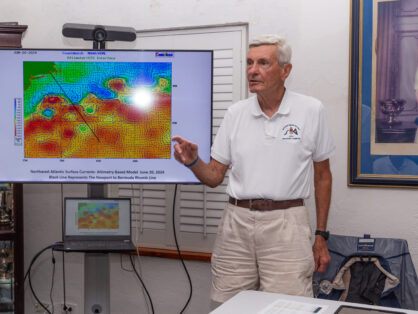
Navigators’ Forum Recap: Expert Insights and Winning Strategies
The 2024 Navigator's Forum

